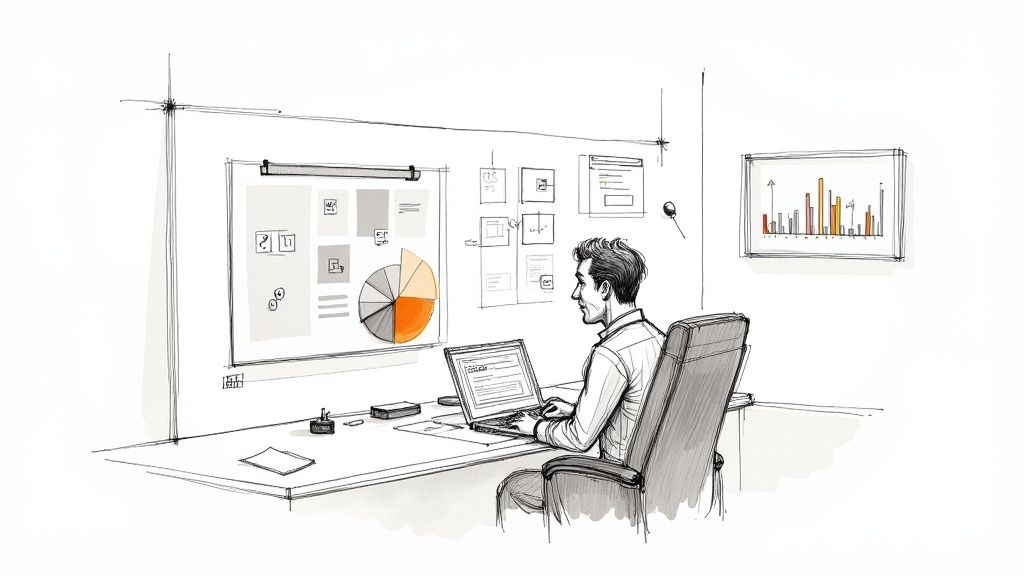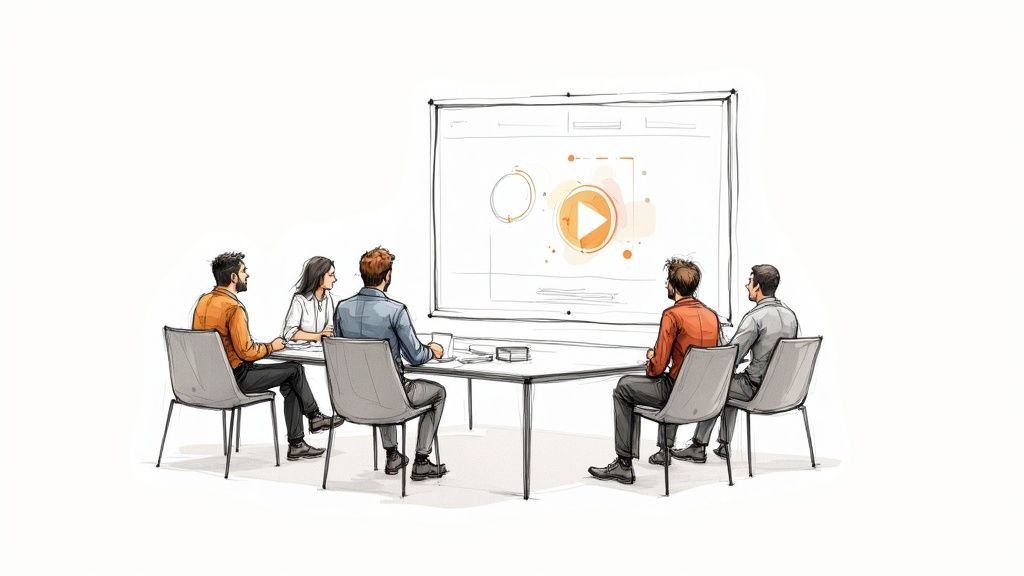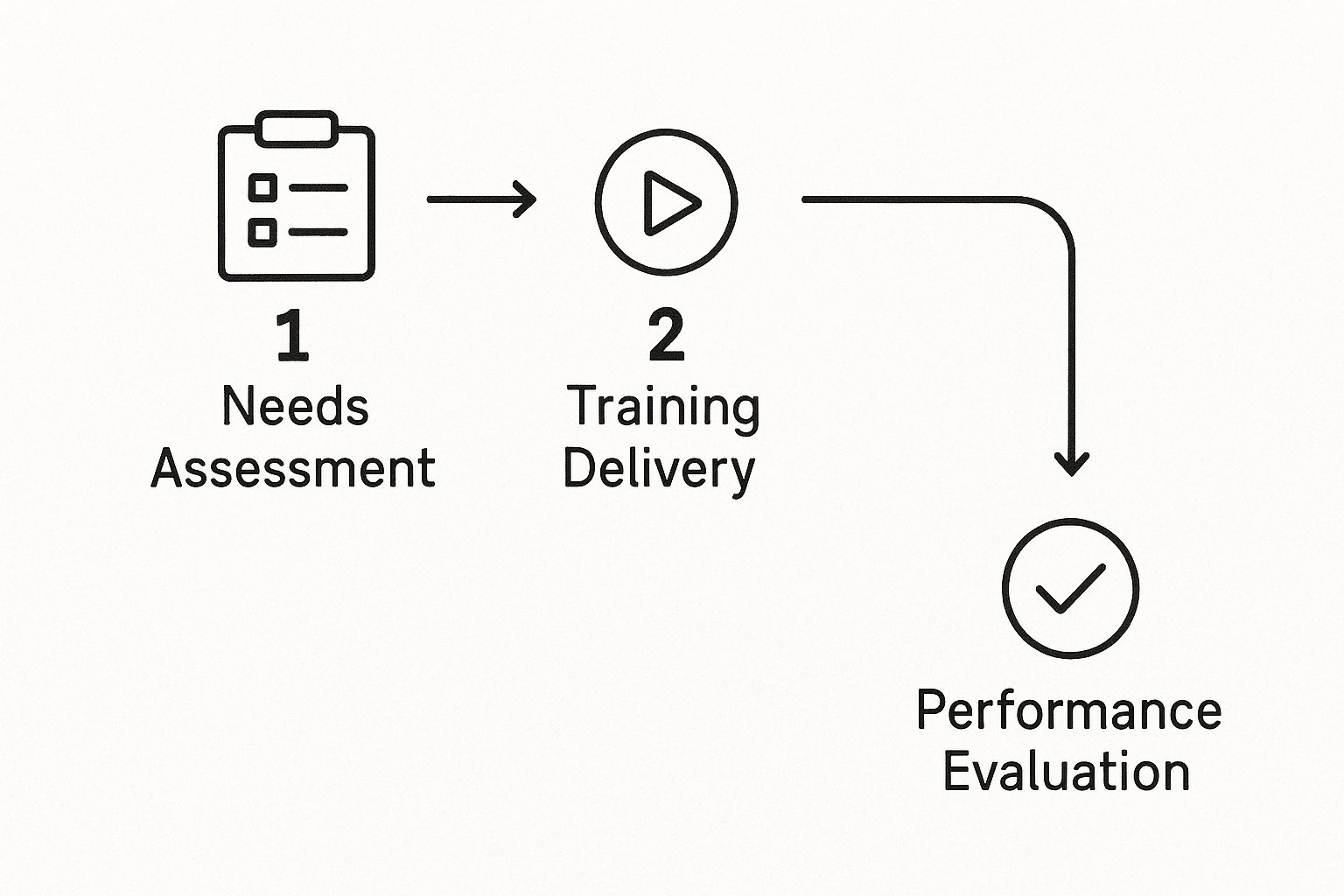
Create an Effective Employee Training Video
An effective employee training video does more than just tick a box. It's a genuinely powerful way to share knowledge, make onboarding smoother for everyone, and give your team's performance a real boost. These videos ditch the old, passive way of learning, offering engaging content that's always on, always consistent, and ready for employees to watch whenever they need a refresher.
Why Training Videos Are a Modern Business Imperative

Let's get past the theory and talk about the real-world business case for putting money into good employee training videos. In today's world, formal training programs aren't just a nice-to-have perk; they're directly tied to how productive and profitable your company is. Video has moved from being a side dish to the main course of any solid learning and development (L&D) strategy.
The Financial Impact of Formalized Training
The link between quality training and revenue has never been clearer. The numbers are pretty staggering: companies that offer in-depth employee training—often built around video—generate a 218% higher income per employee than those without formal programs.
It doesn't stop there. Businesses that commit to providing the right training also see 17% higher productivity and 21% greater profitability. That financial upside comes from having a team that’s more skilled, confident, and efficient. When people have the right tools to do their jobs well, they just perform better.
The numbers don't lie. A strategic investment in training isn't an expense; it's a direct driver of revenue and a powerful competitive advantage in any industry.
Meeting Modern Employee Expectations
People today expect and, frankly, demand good development opportunities. More than half of all employees (59%) feel their job performance is directly tied to the quality of training they get.
Here’s the catch: a mere 29% say they're actually happy with their company's current L&D offerings for career growth. That gap is a huge opportunity for any business willing to step up.
When you provide engaging, relevant training content, you're showing your team you're invested in them. That has a massive impact on retention. People are much more likely to stick around when they see a clear path for growth. This is where a smart training video strategy becomes absolutely essential. If you want to dive deeper, check out these 5 key reasons to use interactive video for training.
Building a Safer, More Prepared Workplace
Beyond just skills and profits, solid training builds a more resilient and prepared organization. Video is an incredible medium for delivering crystal-clear, consistent instructions on everything from standard operating procedures to emergency protocols. It protects your people and your business.
For example, understanding the critical need for CPR training in the workplace highlights why this kind of training is a modern requirement. A well-trained team isn't just more productive; it's also safer and better equipped to handle the unexpected. This is the foundation for creating a culture of preparedness and continuous improvement.
Building Your Training Video Content Strategy
Before you even think about hitting the record button, you need a solid game plan. I’ve seen it time and time again: companies dive headfirst into production, only to end up with an expensive, slick-looking video that completely misses the mark. An employee training video without a clear strategy is like a ship without a rudder—it might look impressive, but it won't get your team where they need to go.
This initial planning phase is everything. It's what separates a video that just gets watched from one that actually changes behavior and improves performance. It all starts with asking the right questions. What problem are we trying to solve? Who, specifically, are we training? And what should they be able to do after watching? Nail these down first, and you'll save yourself a world of headaches and wasted resources later on.
Define Specific Learning Objectives
Your first move is to set crystal-clear learning objectives. Vague goals like "improve sales skills" just won't cut it. You have to get granular. A strong objective is something you can actually measure, defining exactly what an employee should be able to demonstrate after the training.
Think about the difference between a fuzzy goal and a sharp one:
- Instead of "Better sales skills," try: After watching, a new sales rep will be able to list our top three customer pain points and connect each one to a core product feature.
- Instead of "Improve cybersecurity awareness," try: An employee will be able to follow the five-step protocol for identifying and reporting a phishing email.
- Instead of "Train managers on reviews," try: A manager will be able to conduct a performance review using the company’s new three-part feedback framework.
When you have objectives this specific, the rest of the process—from scripting to editing—becomes so much simpler. You'll know exactly what information is essential and what's just fluff that will distract your viewers.
Identify Your Target Audience
Just as important as your "what" is your "who." You can't create a one-size-fits-all training video and expect it to work for everyone. The way you speak to a brand-new hire is completely different from how you'd train a senior engineer on new compliance software.
Take a moment to segment your audience. Are you training:
- New Onboardees? They’ll need foundational knowledge, a welcoming and encouraging tone, and a clear overview of the company culture and essential processes.
- Tenured Staff? These folks need advanced, specific information. They might be resistant to change, so your training has to clearly show them what's in it for them.
- A Specific Department? The language, scenarios, and examples you use must be hyper-relevant to their day-to-day work, or they'll tune out immediately.
The most effective training feels like it was made just for the viewer. Tailoring your message, tone, and examples to the specific audience is the secret to moving from passive viewing to active engagement.
This whole process isn't a one-and-done task. It's a continuous cycle of assessing needs, creating and delivering training, and then evaluating performance to see what's working. This flow diagram breaks it down nicely.

As you can see, the data you get from performance evaluations should directly inform your next round of training. It’s a loop that ensures your content is always getting better and more relevant.
Choose the Right Video Format
Okay, now that you have clear objectives and a well-defined audience, you can finally think about the fun part: choosing the right video format. This decision shouldn't be arbitrary; the format should directly serve your training goal.
For example, a quick screen recording is perfect for a "how-to" on a new software feature. But if you're training on a complex ethical dilemma, an interactive, scenario-based video would be far more effective. For a deeper dive, our comprehensive guide on video training for employees has even more ideas for matching the format to your goals.
To help you get started, here’s a quick breakdown of some common training video formats and when to use them.
Choosing the Right Training Video Format
A comparison of common employee training video formats to help you select the best approach for your specific training goal.
Selecting the right format from the get-go ensures your message is delivered in the most impactful way possible, making the learning experience more engaging and effective for your team.
Producing Truly Engaging and Interactive Videos

Alright, your strategy is locked in. Now comes the fun part: bringing your vision to life. This is where your plans and concepts get turned into a tangible, powerful learning tool for your team.
It's about so much more than just hitting "record." We're crafting an experience—something that grabs attention, communicates with absolute clarity, and actually helps people remember what they learned.
A well-produced employee training video shows respect for your team's time and intelligence. It needs to be something they want to watch, not something they feel forced to sit through. Let's dig into how to make that happen.
Scripting for Clarity and Conversation
Think of the script as the entire foundation of your video. A weak, clunky script will sabotage even the most polished visuals. The key is to avoid writing a formal corporate memo. Instead, aim for a natural, conversational guide that speaks with your employees, not at them.
- Write like you talk. Seriously, read your script out loud. If it sounds robotic or stuffed with jargon, it’s time for a rewrite. Stick to simple language and shorter sentences.
- One idea at a time. Don't try to cram three different learning objectives into a single paragraph. It’s confusing. Guide your viewer logically from one point to the next, giving each idea room to breathe.
- Show, don’t just tell. Instead of simply saying a process is "efficient," write the script to walk the viewer through the steps, pointing out exactly how and where it saves time.
A truly great script anticipates the questions your employees will have and answers them proactively. This approach builds trust and makes the training feel less like a top-down lecture and more like a helpful chat with an expert.
The Power of Storyboards and Shot Lists
Before you even think about filming, your storyboard is going to be your best friend. It’s a visual blueprint that maps out every scene, helping you plan your shots, graphics, and any on-screen text. You don't need to be an artist—stick figures and quick notes work perfectly.
A storyboard helps you:
- Lock in a logical flow and a consistent visual style.
- Spot potential problems before you start filming, saving a ton of time and money.
- Communicate your vision clearly to everyone involved in the project.
Working alongside your storyboard, a shot list details every single camera angle and shot you'll need. This is a simple organizational step, but it's a lifesaver. It ensures you capture all the necessary footage efficiently and prevents those gut-wrenching "we forgot to film that" moments during the editing phase.
Shifting from a passive "watch-and-forget" model to an active "participate-and-learn" approach is the single most important change you can make. Interactivity isn't a feature; it's a fundamental shift in learning philosophy.
Elevating Content with Interactivity
This is where you graduate from a standard video to something truly special. Interactivity turns passive viewing into active participation, a simple change that can have a massive impact on learning outcomes and knowledge retention.
Platforms like Mindstamp are built to make this easy. You can seamlessly embed elements like:
- In-video questions to check for understanding on the spot.
- Clickable hotspots that can reveal extra information or link out to helpful resources.
- Branching scenarios that let employees make choices and see the direct consequences of their actions.
Imagine a sales training video where a new rep has to pick the best response to a common customer objection. With branching, they can see exactly how their choice plays out in a simulated conversation. It creates a safe space to practice, make mistakes, and learn without real-world pressure.
Polishing Your Video in Post-Production
Once all your footage is captured, you head into post-production. This is the editing stage, where you'll assemble your clips, add in graphics, balance the audio, and fine-tune the pacing to create a smooth, professional feel. Good editing is often invisible; it just lets the content shine.
If you want to add an extra layer of quality, consider leveraging video editing outsourcing. A professional editor can bring a level of polish that truly elevates your entire project, making sure it looks and sounds its absolute best.
This is also the point where you’ll bring your interactive ideas to life using Mindstamp. You can precisely time when questions appear, where hotspots are placed, and how all your branching paths connect. The end result should be a cohesive, engaging experience that feels intentional and professionally crafted from start to finish.
Distributing and Integrating Your Training Content
You’ve done the hard part. You've planned, recorded, and polished a brilliant interactive employee training video. It's a huge accomplishment, but all that work is for nothing if your team can't easily find and watch it.
The final, and most critical, piece of the puzzle is distribution. This isn't just about dumping a video file somewhere and shooting off a link. A smart distribution strategy makes sure your videos are secure, slide right into your company's existing workflows, and are organized in a way that actually encourages people to learn.
It’s the bridge between production and real-world impact.
Hosting and Embedding Your Videos
First things first, your videos need a secure and reliable place to live. While public platforms are fine for marketing, they’re a non-starter for internal training due to the lack of security and control. Using a dedicated interactive video platform like Mindstamp is really the only way to go.
Here's why:
- Enhanced Security: You get total control over who sees your videos, which is essential for protecting sensitive company information.
- Centralized Analytics: All your viewer data—from completion rates to quiz scores—is tracked in one convenient dashboard.
- Reliable Performance: Your videos will load fast and play smoothly, without any ads or distracting "recommended for you" nonsense that pulls viewers away.
Once your video is hosted in Mindstamp, you can easily embed it right where your employees already spend their time. The goal is to make training a natural part of their day, not another annoying task to check off a list.
You can embed Mindstamp videos directly into your existing Learning Management System (LMS), company intranet, or even a knowledge base article. That kind of seamless integration creates a truly frictionless experience.
Organizing Content into Learning Paths
Don't just hand your team a library of disconnected videos and hope for the best. You need to guide them. By organizing your content into logical learning paths or playlists, you can transform a bunch of individual videos into a cohesive, structured training program.
This is especially powerful for onboarding new hires or tackling complex subjects that need to be broken down.
For example, a learning path for a new salesperson might look something like this:
- Welcome & Company Culture: A quick introductory video from leadership.
- Product Deep Dive Part 1: A screen recording that walks through the core product features.
- Interactive Scenario: A branching video where they can practice handling common customer objections.
- CRM Best Practices: A short microlearning video on proper data entry.
A well-structured learning path takes the guesswork out of training. It shows employees not just what to learn, but in what order, building their knowledge and confidence one step at a time.
Communicating and Maximizing Adoption
Your final step is to get the word out. You've got to build some awareness and maybe even a little excitement around new training content. A simple, well-crafted announcement can make a massive difference in adoption rates.
Consider sending out a quick company-wide email or a message in your team's Slack or Microsoft Teams channel. Keep it brief and focus on what's in it for them.
Instead of a dry, "A new training video is available," try something more compelling: "Ready to master our new CRM in under 15 minutes? Check out this short interactive guide to save time and close deals faster."
This simple shift in framing presents the training not as a chore, but as a valuable tool for their own success. By making your videos easy to find, logical to follow, and genuinely appealing, you ensure your investment in creating great training actually pays off.
How to Measure the ROI of Your Video Training

You’ve created an amazing employee training video. That's a huge win, but how do you actually prove it's making a difference? The true test of any training isn't just getting people to watch it; it's about whether it sparks real improvement and delivers a solid return on your investment.
To figure that out, you have to go beyond simple view counts and dig into the data that tells the real story. This means getting into the analytics to see how your team is engaging, where they're succeeding, and what might be tripping them up. Only then can you tie your training efforts directly to business results.
Moving Beyond Vanity Metrics
The first thing to do is ignore the surface-level numbers. A video with 1,000 views looks great on paper, but if everyone bailed after 30 seconds, it didn't do its job. Real measurement starts with meaningful engagement metrics—the kind interactive platforms like Mindstamp are built to provide.
These are the numbers you should actually care about:
- Completion Rates: What percentage of employees actually finished the video? A low rate is a red flag that your content might be too long, boring, or just not hitting the mark.
- Viewer Drop-off Points: Where in the video are people clicking away? This data is pure gold. It pinpoints the exact moments your content loses steam, showing you precisely which sections need a rethink.
- Interaction Data: How many viewers clicked on your hotspots, answered questions, or navigated through branching paths? High interaction means your team is actively participating, not just passively watching.
When you analyze these metrics, you get an instant health check on your video. For instance, if you notice a huge drop-off right before a critical learning point, that's your cue to add a compelling visual or an interactive question to pull viewers back in.
Interpreting Learning Analytics for Deeper Insights
Engagement data is a great start, but the next layer is all about knowledge retention. This is where in-video assessments are so powerful. By adding quizzes, polls, and questions right into your training videos, you get instant feedback on whether the information is sinking in.
Connecting Data to Understanding
With a tool like Mindstamp, you can see exactly how your employees answer these questions, which helps you spot specific knowledge gaps.
- Quiz Scores: Are your employees really getting the key concepts? If one particular question is stumping everyone, it’s a clear signal that the part of the video explaining that concept needs to be a lot clearer.
- Individual Performance: You can track how specific employees or departments are doing. This is perfect for identifying who might need a little extra support or some follow-up training.
- Feedback from Questions: Open-ended questions can give you invaluable qualitative feedback, offering direct insight into what your team finds confusing or genuinely helpful.
Think of it this way: you're not just testing your employees; you're testing your content. Low scores aren't a sign of failure—they're an opportunity to refine your training for maximum clarity and impact.
Calculating the True Return on Investment
Now for the big one: connecting all these learning metrics to tangible business results. This is how you prove the real-world value of your training program to the people holding the purse strings. It's all about linking your video analytics to your company's key performance indicators (KPIs).
That connection is often more direct than you'd expect. In fact, IBM data shows a pretty incredible return: for every $1 spent on online training, companies see about $30 in productivity gains. This comes from people learning skills faster and spending less time off the floor. It's no wonder 42% of companies report that eLearning has boosted their revenue.
From Training Data to Business KPIs
Here’s a practical way to make that connection:
- Start with the Goal: What was the original business reason for the training? Was it to cut down on safety incidents, boost sales conversions, or reduce customer support tickets?
- Measure Before and After: Get baseline data for that KPI before you launch the training. Once the training is done, measure it again over a specific period, like the next quarter.
- Connect to Training Metrics: Now, look for correlations. Did the sales team with the highest quiz scores also see the biggest jump in their conversion rates? Did the department that had a 100% completion rate on the new safety video also have zero incidents?
Let's say you created a training video on a new software feature for your customer support team. You could compare the average handle time for related tickets before and after the training. A sharp decrease in handle time is a direct, measurable ROI. Our guide on how to measure training effectiveness dives even deeper into strategies for making these connections.
By taking this data-driven approach, your employee training video program stops being a line item on a budget and becomes a proven engine for business growth.
Common Questions About Training Video Production
As you start turning your training strategy into actual videos, you're bound to run into some practical questions. It's totally normal. Building an effective employee training video program means knowing how to handle these common hurdles. Let's dig into some of the most frequent questions we hear from teams getting their video programs off the ground.
How Long Should an Employee Training Video Be?
This is probably the number one question we get, and the real answer is: it depends on your goal. There’s no perfect length, but some solid guidelines will help you keep people watching and actually remembering what you taught them.
For super-focused training on one specific task or process, think microlearning. A video that’s 3-7 minutes long is the sweet spot. This length respects today's attention spans and is perfect for a quick "how-to" refresher an employee might pull up on their phone. The trick is to nail one clear learning objective per video. Don't try to do too much.
Now, if you're tackling a bigger topic—like a full onboarding module or explaining a complex new company policy—don't even think about making a 45-minute epic. Nobody will finish it. A much smarter approach is to break that content into a series or playlist of shorter, more focused videos. All the research shows that viewer attention takes a nosedive after the 10-minute mark. If you absolutely have to go longer, you need to bake in interactivity. Using in-video questions or clickable chapter markers becomes non-negotiable to keep viewers locked in.
The golden rule? Respect your employee's time. A short, sharp video that gets right to the point will always beat a long, rambling one. When in doubt, make it shorter.
What Equipment Do I Need to Get Started?
You can get going with a lot less than you probably think. Fancy, high-end gear is nice, but it’s definitely not a must-have for creating a training video that looks professional and gets the job done.
Here’s the absolute most critical thing: audio. People will forgive video that's a little grainy, but they will instantly bail if the audio is muffled, quiet, or full of distracting background noise. A modern smartphone records surprisingly good video, but you really should pair it with an external microphone. A simple lavalier (lapel) mic or a decent USB microphone is an affordable investment that will make a massive difference.
Beyond sound, just focus on these basics:
- Lighting: Good lighting doesn't mean a full studio setup. Try facing a window to use natural light. If that's not an option, an inexpensive ring light can work wonders to eliminate shadows and create a clean, professional look.
- Screen Recording Software: If your training involves software walkthroughs or showing a process on-screen, you’ll need a screen recorder. There are plenty of user-friendly options out there that make it simple to capture your screen and voice simultaneously.
- A Quiet Space: No studio required. A small office or an empty conference room with minimal echo will work just fine. Just close the door and put a sign up!
How Can I Make Compliance Training Less Boring?
Ah, compliance training. It has a well-earned reputation for being painfully dull, but it doesn’t have to be. The secret is to stop listing dry rules from a manual and start telling stories your employees can actually relate to.
Instead of just reciting policies, use relatable scenarios. Film short, narrative-driven videos that show the real-world impact of making the right—and wrong—decisions. For example, rather than a slide listing data security protocols, create a short video about an employee who accidentally clicks a phishing link and the steps the team takes to handle it.
This is where interactivity really shines. Using a platform like Mindstamp, you can build branching scenarios where employees make choices in a simulated situation and see the immediate consequences. This active participation flips the script, turning them from passive viewers into engaged problem-solvers. Sprinkling in short, non-graded knowledge checks after key points is also a great way to reinforce information and break up the monotony.
What Are the Biggest Mistakes to Avoid?
Sometimes, knowing what not to do is just as important as knowing what to do. Sidestepping these common pitfalls will save you a world of time, money, and headaches.
Here are the biggest mistakes we see that can sink an otherwise solid training video:
- Poor Audio Quality: This is the ultimate deal-breaker. If your team can't hear you clearly, the message is completely lost. It immediately feels unprofessional and makes people tune out.
- Information Overload: Trying to cram a semester's worth of information into one video is a surefire way to overwhelm your audience. When you do that, almost nothing sticks.
- No Clear Learning Objective: A video without a specific, measurable goal isn't training—it's just content. It will feel unfocused and won't lead to any real improvement in skills or behavior.
- Creating a Passive Experience: Just pointing a camera at someone talking for 15 minutes is a recipe for boredom. Without engaging visuals, graphics, or interactive elements, you’re practically begging your audience to multitask.
- Forgetting to Measure: If you aren’t tracking engagement and comprehension, you’re flying blind. You have no idea if the training is actually working, which makes it impossible to improve or prove its value.
Steering clear of these common blunders will put you way ahead of the curve and help you create training that your employees will thank you for.
Ready to transform your employee training from a passive chore into an engaging, measurable experience? With Mindstamp, you can easily add questions, branching logic, and powerful analytics to any video. Start your free trial today and see how interactive video can change the way your team learns.
Get Started Now
Mindstamp is easy to use, incredibly capable, and supported by an amazing team. Join us!



Try Mindstamp Free










